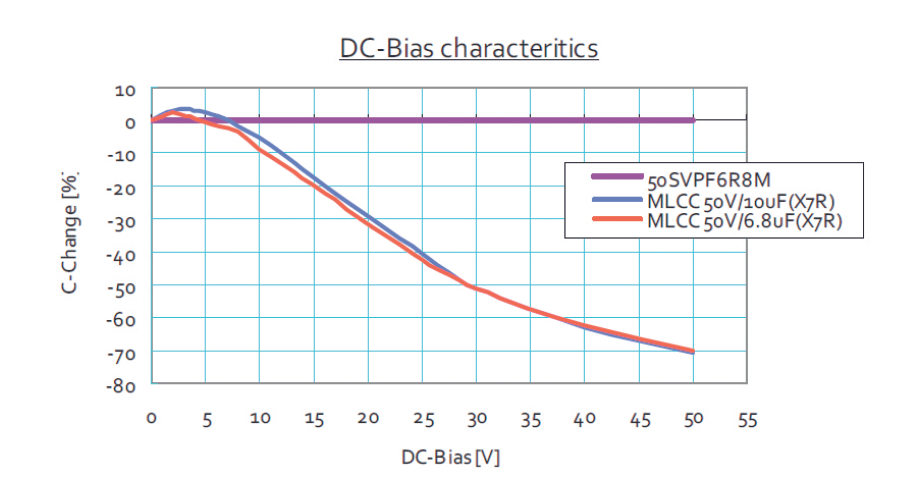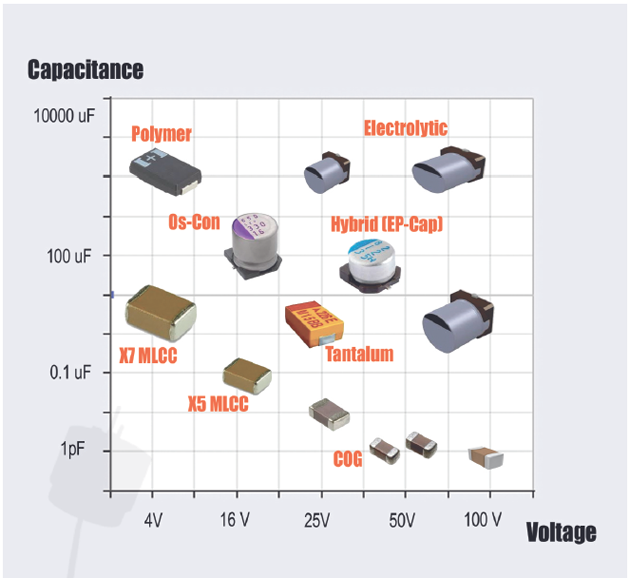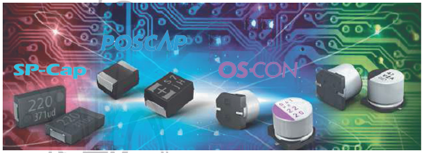Zoltán Kiss- Area Sales Manager - East Europe - Endrich GmbH.
Voltage characteristic of capacitors
8 December 2014

Summary :
Very often the multi layer ceramic capacitors (MLCCs) are responsible of unexpected noise appearance in electric circuits. The most usual reason of this negative behavior is the DC biasdependence. The more the applied voltage is approaching the rated voltage, the less effective capacitance the capacitor has. This phenomenon is called the voltage characteristics of the device, and capacitors are said to have good voltage characteristics, when the change is small. This article we are going to review the reasons leading to this effect.
Comparison of capacitors
When designers are about to select capacitors for the circuits, there are a lot of properties that should be aware of in order to be able to select he right solution. The maximum rated voltage, the low ESR value, the lifetime, the temperature effects are all factors to be considered. Key of the selection criteria can be size and cost. Ceramic capacitors are the lowest cost devices, used primarily for decoupling and bypass applications. They are not polarized, having the lowest ESR and due to small sizes having the lowest ESL value, therefore very popular for the designs. However they have some limitations that should be kept in mind, most important ones are the DC-Bias problem.
DC BIAS Characteristics
DC bias characteristics describe the capacitance deviation from the nominal capacitance of the capacitor when applied DC voltage approaches the nominal voltage. A lot of different capacitors utilizing ceramic dielectrics (MLCC, monolithic, disc) show high decrease of effective capacitance, while conductive polymer aluminum electrolytic capacitors, conductive polymer tantalum electrolytic capacitors are not much affected.

The reason of this capacitance change can be explained by the crystalline structure of the raw material. In the high dielectric constant capacitor types of monolithic ceramic capacitors, the crystal structure of the used raw material changes with the temperature. Especially below the Curie temperature (cca. 1 25 C) the so called spontaneous polarization occurs without applied external electric field. The most of the dipoles in the dielectrics are flipping back and forth with the AC voltage. In case of electric field is applied, this spontaneous electric polarization can change orientation, this is the so called Ferro electricity (analog to the ferromagnetism). Without an external DC voltage, polarization is spontaneous, but by applying it, the polarization is forced to the direction of the electric field in the dielectric. More and more dipoles are locked (approaching to saturation), and less and less operating ones can align themselves to the AC signal. As the capacitance is defined by the number of operant dipoles, it becomes lower than before applying the bias. This is the mechanism of decrease in the capacitance after applying DC voltage. The problem of DC-BIAS is affecting the class 2 or 3 ferroelectric, non linear dielectrics, such as X7R, X5R, X6S, X7S, X7T, Y5v etc. On the figure it can be seen, that applying DC voltage to the MLCC capacitors of e.g. X7 dielectric type, the effective capacitance will decrease with 70% by approaching the rated voltage. This phenomenon is not applicable however for Panasonic’s OsCon type of capacitors with organic semiconductive polymer electrolyte or other polymer or tantalum dielectric ones.
When using MLCCs it s necessary to use voltage derating. In case higher voltages should be considered as rated voltage, better to replace these types with polymer capacitors, as they should not be derated as voltage regard. This means that there will be a good chance for downsizing the circuit. Panasonic’s PosCap, SP-Cap and OsCon series as well as SUNCon’s EP-Caps are keeping their capacitance stabile on the rated voltage.


| Share on Facebook | Share on LinkedIn |
References
This article has been published on the following locations:
| # | Media | Link |
|---|---|---|
| 1 | Elektronet 2014/8 | Elektronet : elektronikai informatikai szakfolyóirat, 2014. (23. évf.) 8. sz. 17. old. |
| 2 | Elektronet online | Kondenzátorok feszültség-karakterisztikája |
| 3 | Hungarian version | Kondenzátorok feszültségkarakterisztikája |
| 4 | TechStory M2M | Kondenzátorok feszültségkarakterisztikája |


